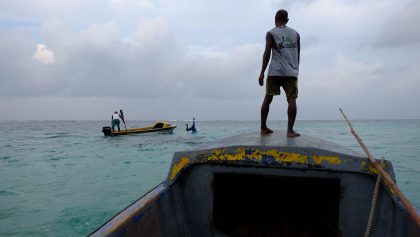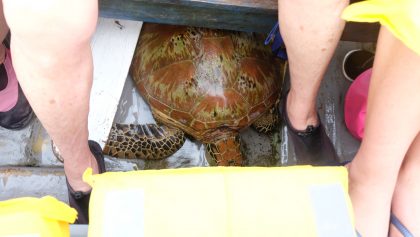Tagging turtles in Tetepare – the Solomon Islands’ Jurassic Park
“Beep, beep, beep, beep, beep … ”.
The piercing drone of my phone alarm swirled around our bungalow –a sound you’re not supposed to hear when you’re on holiday.
Dreary eyed I slowly woke up, the brutal crashing of waves even briefly overpowered the beeping as I resisted throwing the phone in the Coral Sea.
But there was a reason for waking up at 5.50am whilst on holiday – we were on Tetepare Island. And this morning we were looking for turtles.
The uninhabited island is like visiting a real-life Jurassic Park.
Sitting in the southern depths of the Solomons’ gorgeous Western Province – a sometimes treacherous two-hour boat journey from Munda – it is the closest thing you can get to feeling like Álvaro de Mendaña y Neira – the Spanish explorer who first came across the Solomons.
The island is alive.
Noise is everywhere – whether it’s the wind hurling off the Coral Sea, ancient lizards crawling through the grass, megapode birds sifting for food or the teeming bird life – the only thing missing is the roar of a Tyrannosaurus Rex.
Once inhabited with a number of tribes, at around 1860 the people of Tetepare abandoned the island with three potential causes: dysentery, headhunting and curses – and perhaps a combination of all three – attributed to the mass exodus.
Today it is a conservation site operated by 12 workers (the only inhabitants of the 25km-long island) who look after it on behalf of the Tetepare Descendants Association and a number of other worldwide conservation partners.
And it is a nature-lovers dream.
The eco lodge, with its handful of traditional bungalows, is on the site of an old coconut plantation with only 13 guests allowed on the island at each time.
Tetepare has a number of nature-based activities available for guests, whether that be searching for Dugongs (which are now, unfortunately, very rare because of a tsunami late last decade), trekking through the jungle, camping out to see leatherback turtles and some of the best snorkeling you will ever do.
For my group, the turtles were calling.
Turtles, or Foforo in the local language, are abundant in the waters around Tetepare. The local team has tagged almost 1000 Hawksbill and Green turtles for research purposes, and many just live in the protected reef area outside the eco lodge.
We set off at 6.30am. The wind was howling, but being on a sharp point of the island, one side of the eco lodge is always protected.
Hobete Gau, the island’s main turtle hunter led the charge.
Two boats, one with Hobete and a driver and the other with us, drove around searching for the little fellas.
And they were quick.
We soon spot some. Without distressing the turtles too much, the boats attempt to round them into an area – like a pair of fiberglass sheep dogs – with Hobete then jumping in the water to grab them.
It is quite a spectacular scene.
Hobete’s eyes almost pop out his face as he prepares to jump in, obviously using his years of experience studying the turtles’ movements to judge the perfect time to jump.
With the sun rising over Tetepare’s prehistoric mountains and thick jungle, Hobete, grabs one and with the help of his team lobs a large Hawksbill into our boat.
This one has already been tagged, and it promptly moves under the legs of a group of guests where it sits for the rest of the boat ride.
Hobete ends up grabbing two more.
We take them back to land where the team either tags the turtles, or records the details of those who have tags, assessing the animal’s weight and shell size.
He told SIBC Tetepare was one of two research areas in the Solomons (a country with an abundant turtle population) and helped asses the health of the endangered Hawksbill and Green turtles with the results sent to Western Samoa for assessment.
“This one is 20 years old,” he told SIBC, as he squeezed the tropical seawater out of his drenched shirt. “But it’s not laying yet.”
The animals are released and crawl back into the ocean to explore another day.
From there it was a walk up to Tetepare’s “eatery” for a tasty breakfast – the food on Tetepare is nothing short of spectacular – and to plan the rest of the day.
That included an afternoon nap – if only those turtles knew how to sleep in…







